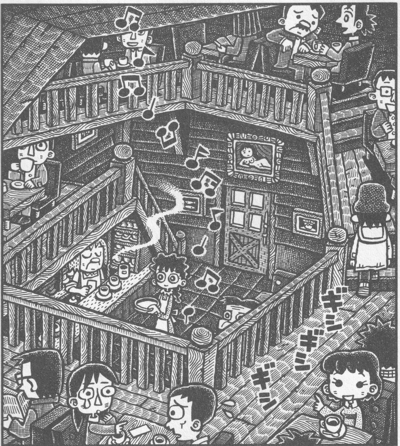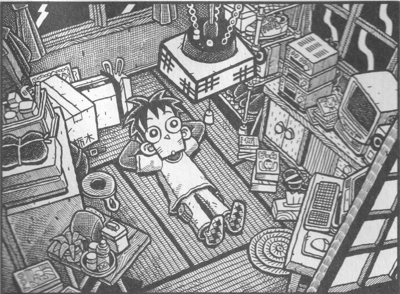For the newsletter this month, I wrote about reading monthly manga magazines. It’s been a revelation. Like suddenly being subscribed to 20 random Netflix shows you didn’t know existed. That sometimes go on break. For 590 yen/month As a new reader, I’ve been pleasantly surprised with the two issues so far.
Cocohana has been good, but I’m not sure if there are any series that I’d go out of my way to catch up on with collected volumes. What I was really looking for was a way to increase the volume of natural Japanese dialogue I was reading, for work purposes, and it’s absolutely providing good repetitions on that front.
Comic Beam, on the other hand, I’m finding really compelling. I mentioned 鳥トマト (Tori Tomato) in the newsletter. She had a one-off piece in the November issue called マイお兄ちゃん that was really complex.
But I’m also finding グリッチ by シマ・シンヤ (Shima Shinya) and アン・グラ by 丸尾末広 (Maruo Suehiro) really interesting. Suehiro seems to be right around the same generation as Murakami, maybe a little younger, and they’re both a generation or so after 楳図かずお (Umezz Kazuo), whom I’m interested to read after seeing an art exhibit at the Abeno Harukas Art Museum.
View this post on Instagram
I checked out the Abeno Harukasu Art Museum yesterday for the first day of the Umezz Kazuo exhibit. Wasn't familiar with his work but am now interested to read something. pic.twitter.com/LeQLgfcddv
— Daniel Morales (@howtojapanese) September 18, 2022
Maruo and Umezz are a lot more abstract and trippy compared to the Cocohana content, and Shima Shinya is somewhere in between – a standard storytelling style with unique art and quirky sci-fi story content.
I’ve been monitoring Mercari for Umezz Kazuo manga, but I actually just did a quick search on Jmty.jp and discovered a set of his manga for 1,000 yen here in Osaka. The post is a bit old, so I have my fingers crossed that it’s still valid because that’s a great price for a complete set and just a few stops away on the train.
So this is your push to find a monthly magazine—any will do—and see what’s in there. You could do the same with literary magazines, to be fair, but the lift would be much heavier than manga. Just thinking about getting through an entire issue of 文藝春秋 within a month makes me break out in a cold sweat!






